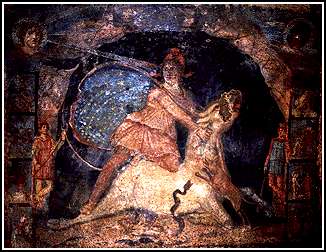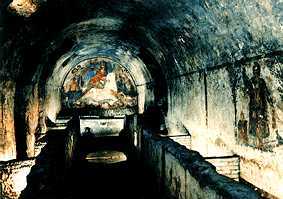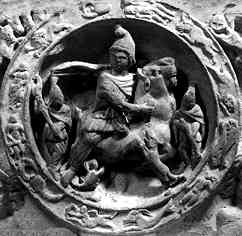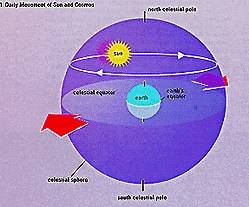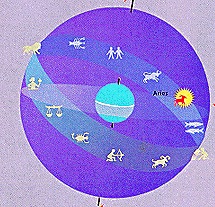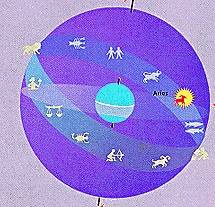MITHRAISM
The Cosmic Mysteries of Mithras
The Cosmic Mysteries of Mithras

by David Ulansey
Author of
THE ORIGINS OF THE MITHRAIC MYSTERIES
(Oxford University Press, 1991)
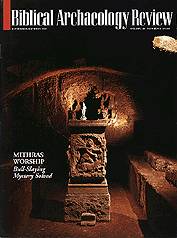
The following essay is adapted from my article,
"Solving the Mithraic Mysteries"
Biblical Archaeology Review
(vol. 20, #5 [September/October 1994] pp. 40-53)
This article is a summary of my book on Mithraism,
THE ORIGINS OF THE MITHRAIC MYSTERIES
(Oxford University Press, revised paperback, 1991)
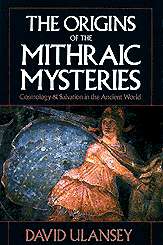
[To order this book (for $13.95), click here.]

The Encyclopedia Britannica has given this page
its "Web's Best Sites" award.
The Cosmic Mysteries of Mithras
The Cosmic Mysteries of Mithras
(Note: complete documentation for the following essay can be found
in my book on Mithraism, The Origins of the Mithraic Mysteries,
and in my articles listed at the bottom of this page.)
The ancient Roman religion known as the Mithraic mysteries has captivated the imaginations of scholars for generations. There are two reasons for this fascination. First, like the other ancient "mystery religions," such as the Eleusinian mysteries and the mysteries of Isis, Mithraism maintained strict secrecy about its teachings and practices, revealing them only to initiates. As a result, reconstructing the beliefs of the Mithraic devotees has posed an enormously intriguing challenge to scholarly ingenuity. Second, Mithraism arose in the Mediterranean world at exactly the same time as did Christianity, and thus the study of the cult holds the promise of shedding vital light on the cultural dynamics that led to the rise of Christianity.
Owing to the cult's secrecy, we possess almost no literary evidence about the beliefs of Mithraism. The few texts that do refer to the cult come not from Mithraic devotees themselves, but rather from outsiders such as early Church fathers, who mentioned Mithraism in order to attack it, and Platonic philosophers, who attempted to find support in Mithraic symbolism for their own philosophical ideas. However, although our literary sources for Mithraism are extremely sparse, an abundance of material evidence for the cult exists in the many Mithraic temples and artifacts that archaeologists have found scattered throughout the Roman empire, from England in the north and west to Palestine in the south and east. The temples, called mithraea by scholars, were usually built underground in imitation of caves. These subterranean temples were filled with an extremely elaborate iconography: carved reliefs, statues, and paintings, depicting a variety of enigmatic figures and scenes. This iconography is our primary source of knowledge about Mithraic beliefs, but because we do not have any written accounts of its meaning the ideas that it expresses have proven extraordinarily difficult to decipher.

Underground Mithraic temple in Rome
The typical mithraeum was a small rectangular subterranean chamber, on the order of 75 feet by 30 feet with a vaulted ceiling. An aisle usually ran lengthwise down the center of the temple, with a stone bench on either side two or three feet high on which the cult's members would recline during their meetings. On average a mithraeum could hold perhaps twenty to thirty people at a time. At the back of the mithraeum at the end of the aisle was always found a representation-- usually a carved relief but sometimes a statue or painting-- of the central icon of Mithraism: the so-called tauroctony or "bull-slaying scene" in which the god of the cult, Mithras, accompanied by a dog, a snake, a raven, and a scorpion, is shown in the act of killing a bull. Other parts of the temple were decorated with various scenes and figures. There were many hundreds-- perhaps thousands-- of Mithraic temples in the Roman empire. The greatest concentrations have been found in the city of Rome itself, and in those places in the empire (often in the most distant frontiers) where Roman soldiers-- who made up a major segment of the cult's membership-- were stationed.
Mithraeum in Capua, Italy
Our earliest evidence for the Mithraic mysteries places their appearance in the middle of the first century B.C.: the historian Plutarch says that in 67 B.C. a large band of pirates based in Cilicia (a province on the southeastern coast of Asia Minor) were practicing "secret rites" of Mithras. The earliest physical remains of the cult date from around the end of the first century A.D., and Mithraism reached its height of popularity in the third century. In addition to soldiers, the cult's membership included significant numbers of bureaucrats and merchants. Women were excluded. Mithraism declined with the rise to power of Christianity, until the beginning of the fifth century, when Christianity became strong enough to exterminate by force rival religions such as Mithraism.
For most of the twentieth century it has been assumed that Mithraism was imported from Iran, and that Mithraic iconography must therefore represent ideas drawn from ancient Iranian mythology. The reason for this is that the name of the god worshipped in the cult, Mithras, is a Greek and Latin form of the name of an ancient Iranian god, Mithra; in addition, Roman authors themselves expressed a belief that the cult was Iranian in origin. At the end of the nineteenth century Franz Cumont, the great Belgian historian of ancient religion, published a magisterial two- volume work on the Mithraic mysteries based on the assumption of the Iranian origins of the cult. Cumont's work immediately became accepted as the definitive study of the cult, and remained virtually unchallenged for over seventy years.
There were, however, a number of serious problems with Cumont's assumption that the Mithraic mysteries derived from ancient Iranian religion. Most significant among these is that there is no parallel in ancient Iran to the iconography which is the primary fact of the Roman Mithraic cult. For example, as already mentioned, by far the most important icon in the Roman cult was the tauroctony. This scene shows Mithras in the act of killing a bull, accompanied by a dog, a snake, a raven, and a scorpion; the scene is depicted as taking place inside a cave like the mithraeum itself. This icon was located in the most important place in every mithraeum, and therefore must have been an expression of the central myth of the Roman cult. Thus, if the god Mithras of the Roman religion was actually the Iranian god Mithra, we should expect to find in Iranian mythology a story in which Mithra kills a bull. However, the fact is that no such Iranian myth exists: in no known Iranian text does Mithra have anything to do with killing a bull.
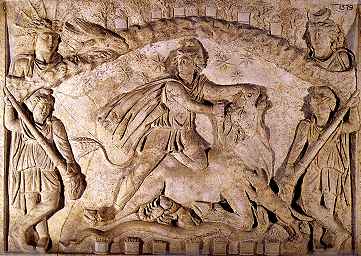
Mithras killing bull
Franz Cumont had responded to this problem by focusing on an ancient Iranian text in which a bull is indeed killed, but in which the bull-slayer is not Mithra but rather Ahriman, the force of cosmic evil in Iranian religion. Cumont argued that there must have existed a variant of this myth-- a variant for which there was, however, no actual evidence-- in which the bull-slayer had been transformed from Ahriman to Mithra. It was this purely hypothetical variant on the myth of Ahriman's killing of a bull that according to Cumont lay behind the tauroctony icon of the Roman cult of Mithras.
In the absence of any convincing alternative, Cumont's explanation satisfied scholars for more than seventy years. However, in 1971 the First International Congress of Mithraic Studies was held in Manchester England, and in the course of this Congress Cumont's theories came under concerted attack. Was it not possible, scholars at the Congress asked, that the Roman cult of Mithras was actually a new religion, and had simply borrowed the name of an Iranian god in order to give itself an exotic oriental flavor? If such a scenario seemed plausible, these scholars argued, one could no longer assume without question that the proper way to interpret Mithraism was to find parallels to its elements in ancient Iranian religion. In particular, Franz Cumont's interpretation of the tauroctony as representing an Iranian myth was now no longer unquestionable. Thus from 1971 on, the meaning of the Mithraic tauroctony suddenly became a mystery: if this bull-slaying icon did not represent an ancient Iranian myth, what did it represent?
Within a few years after the 1971 Congress, a radically different approach to explaining the tauroctony began to be pursued by a number of scholars. It is not an exaggeration to say that this approach has in just the past few years succeeded in completely revolutionizing the study of the Mithraic mysteries. According to the proponents of this interpretation, the tauroctony is not, as Cumont and his followers claimed, a pictorial representation of an Iranian myth, but is rather something utterly different: namely, an astronomical star map!
This remarkable explanation of the tauroctony is based on two facts. First, every figure found in the standard tauroctony has a parallel among a group of constellations located along a continuous band in the sky: the bull is paralleled by Taurus, the dog by Canis Minor, the snake by Hydra, the raven by Corvus, and the scorpion by Scorpio. Second, Mithraic iconography in general is pervaded by explicit astronomical imagery: the zodiac, planets, sun, moon, and stars are often portrayed in Mithraic art (note for example the stars around the head of Mithras in the carving of the tauroctony illustrated above); in addition, numerous ancient authors speak about astronomical subjects in connection with Mithraism. In the writings of the Neoplatonic philosopher Porphyry, for example, we find recorded a tradition that the cave which is depicted in the tauroctony and which the underground Mithraic temples were designed to imitate was intended to be "an image of the cosmos." Given the general presence of astronomical motifs in Mithraic art and ideology, the parallel noted above between the tauroctony-figures and constellations is unlikely to be coincidence.
Tauroctony encircled by zodiac
My own research over the past decade has been devoted to discovering why these particular constellations might have been seen as especially important, and how an icon representing them could have come to form the core of a powerful religious movement in the Roman Empire.
In order to answer these questions, we must first have in mind a few facts about ancient cosmology. Today we know that the earth rotates on its axis once a day, and revolves around the sun once a year. However, Greco-Roman astronomy at the time of the Mithraic mysteries was based on a so-called "geocentric" cosmology, according to which the earth was fixed and immovable at the center of the universe and everything went around it. In this cosmology the universe itself was imagined as being bounded by a great sphere to which the stars, arranged in the various constellations, were attached. So, while we today understand that the earth rotates on its axis once every day, in antiquity it was believed instead that once a day the great sphere of the stars rotated around the earth, spinning on an axis that ran from the sphere's north pole to its south pole. As it spun, the cosmic sphere was believed to carry the sun along with it, resulting in the apparent movment of the sun around the earth once a day.
This diagram shows the daily rotation of the cosmic sphere around the earth according to the "geocentric" cosmology. As shown here, the sun is carried along by the cosmic sphere around the earth once a day. However, as explained below, in the "geocentric" cosmology the sun was also believed to possess a second movement beyond its daily rotation with the cosmic sphere: namely, its yearly revolution along the circle of the "zodiac."In addition to this daily rotation of the cosmic sphere carrying the sun along with it, the ancients also attributed a second, slower motion to the sun. While today we know that the earth revolves around the sun once a year, in antiquity it was believed instead that once a year the sun-- which was understood as being closer to the earth than the sphere of the stars-- traveled around the earth, tracing a great circle in the sky against the background of the constellations. This circle traced by the sun during the course of the year was known as the "zodiac"-- a word meaning "living figures," which was a reference to the fact that as the sun moved along the circle of the zodiac it passed in front of twelve different constellations which were represented as having various animal and human forms.
Zodiac (circle of 12 figures) with sun in Aries. In the "geocentric" cosmology the sun was believed to move along this circle around the earth once a year. The other cosmic circle shown here, parallel to the earth's equator, is called the "celestial equator."Because the ancients believed in the real existence of the great sphere of the stars, its various parts-- such as its axis and poles-- played a central role in the cosmology of the time. In particular, one important attribute of the sphere of the stars was much better known in antiquity than it is today: namely, its equator, known as the "celestial equator." Just as the earth's equator is defined as a circle around the earth equidistant from the north and south poles, so the celestial equator was understood as a circle around the sphere of the stars equidistant from the sphere's poles. The circle of the celestial equator was seen as having a particularly special importance because of the two points where it crosses the circle of the zodiac: for these two points are the equinoxes, that is, the places where the sun, in its movement along the zodiac, appears to be on the first day of spring and the first day of autumn. Thus the celestial equator was responsible for defining the seasons, and hence had a very concrete significance in addition to its abstract astronomical meaning.
As a result, the celestial equator was often described in ancient popular literature about the stars. Plato, for example, in his dialogue Timaeus said that when the creator of the universe first formed the cosmos, he shaped its substance in the form of the letter X, representing the intersection of the two celestial circles of the zodiac and the celestial equator. This cross-shaped symbol was often depicted in ancient art to indicate the cosmic sphere. In fact, one of the most famous examples of this motif is a Mithraic stone carving showing the so-called "lion-headed god," whose image is often found in Mithraic temples, standing on a globe that is marked with the cross representing the two circles of the zodiac and the celestial equator.
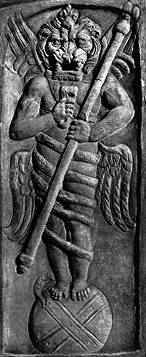
Lion-headed god standing on globe with crossed circles
One final fact about the celestial equator is crucial: namely, that it does not remain fixed, but rather possesses a slow movement known as the "precession of the equinoxes." This movement, we know today, is caused by a wobble in the earth's rotation on its axis. As a result of this wobble, the celestial equator appears to change its position over the course of thousands of years. This movement is known as the precession of the equinoxes because its most easily observable effect is a change in the positions of the equinoxes, the places where the celestial equator crosses the zodiac. In particular, the precession results in the equinoxes moving slowly backward along the zodiac, passing through one zodiacal constellation every 2,160 years and through the entire zodiac every 25,920 years. Thus, for example, today the spring equinox is in the constellation of Pisces, but in a few hundred years it will be moving into Aquarius (the so-called "dawning of the Age of Aquarius"). More to our point here, in Greco-Roman times the spring equinox was in the constellation Aries, which it had entered around 2,000 B.C.
It is this phenomenon of the precession of the equinoxes that provides the key to unlocking the secret of the astronomical symbolism of the Mithraic tauroctony. For the constellations pictured in the standard tauroctony have one thing in common: namely, they all lay on the celestial equator as it was positioned during the epoch immediately preceeding the Greco-Roman "Age of Aries." During that earlier age, which we may call the "Age of Taurus," lasting from around 4,000 to 2,000 B.C., the celestial equator passed through Taurus the Bull (the spring equinox of that epoch), Canis Minor the Dog, Hydra the Snake, Corvus the Raven, and Scorpio the Scorpion (the autumn equinox): that is, precisely the constellations represented in the Mithraic tauroctony.
In the above diagram the celestial equator intersects the zodiac in Aries. This was the situation during the "Age of Aries." The sun is here pictured (in Aries) as it was located on the day of the spring equinox in that age.
Here the cosmic axis has wobbled, so that the celestial equator intersects the zodiac in Taurus-- the situation during the "Age of Taurus." The sun is here pictured (in Taurus) as it was located on the day of the spring equinox in that age. In this "Age of Taurus" the celestial equator passed through Taurus, Canis Minor, Hydra, Corvus, and Scorpio: precisely the constellations pictured in the Mithraic bull-slaying icon.In fact, we may even go one step further. For during the Age of Taurus, when the equinoxes were in Taurus and Scorpio, the two solstices-- which are also shifted by the precession-- were in Leo the Lion and Aquarius the Waterbearer. (In the above diagram of the "Age of Taurus," Leo and Aquarius are the northernmost and southernmost constellations of the zodiacal circle respectively-- these were the positions of the summer and winter solstices in that age.) It is thus of great interest to note that in certain regions of the Roman empire a pair of symbols was sometimes added to the tauroctony: namely, a lion and a cup. These symbols must represent the constellations Leo and Aquarius, the locations of the solstices during the Age of Taurus. Thus all of the figures found in the tauroctony represent constellations that had a special position in the sky during the Age of Taurus.
The Mithraic tauroctony, then, was apparently designed as a symbolic representation of the astronomical situation that obtained during the Age of Taurus. But what religious significance could this have had, so that the tauroctony could have come to form the central icon of a powerful cult? The answer to this question lies in the fact that the phenomenon of the precession of the equinoxes was unknown throughout most of antiquity: it was discovered for the first time around 128 B.C. by the great Greek astronomer Hipparchus. Today we know that the precession is caused by a wobble in the earth's rotation on its axis. However, for Hipparchus-- because he held to the ancient geocentric cosmology in which the earth was believed to be immovable-- what we today know to be a movement of the earth could only be understood as a movement of the entire cosmic sphere. In other words, Hipparchus's discovery amounted to the discovery that the entire universe was moving in a way that no one had ever been aware of before!
At the time Hipparchus made his discovery, Mediterranean intellectual and religious life was pervaded by astrological beliefs. It was widely believed that the stars and planets were living gods, and that their movements controlled all aspects of human existence. In addition, at this time most people believed in what scholars call "astral immortality": that is, the idea that after death the human soul ascends up through the heavenly spheres to an afterlife in the pure and eternal world of the stars. In time, the celestial ascent of the soul came to be seen as a difficult voyage, requiring secret passwords to be recited at each level of the journey. In such circumstances, Hipparchus's discovery would have had profound religious implications. A new force had been detected capable of shifting the cosmic sphere: was it not likely that this new force was a sign of the activity of a new god, a god so powerful that he was capable of moving the entire universe?
Hipparchus's discovery of the precession made it clear that before the Greco-Roman period, in which the spring equinox was in the constellation of Aries the Ram, the spring equinox had last been in Taurus the Bull. Thus, an obvious symbol for the phenomenon of the precession would have been the death of a bull, symbolizing the end of the "Age of Taurus" brought about by the precession. And if the precession was believed to be caused by a new god, then that god would naturally become the agent of the death of the bull: hence, the "bull-slayer."
This, I propose, is the origin and nature of Mithras the cosmic bull-slayer. His killing of the bull symbolizes his supreme power: namely, the power to move the entire universe, which he had demonstrated by shifting the cosmic sphere in such a way that the spring equinox had moved out of Taurus the Bull.
Given the pervasive influence in the Greco-Roman period of astrology and "astral immortality," a god possessing such a literally world-shaking power would clearly have been eminently worthy of worship: since he had control over the cosmos, he would automatically have power over the astrological forces determining life on earth, and would also possess the ability to guarantee the soul a safe journey through the celestial spheres after death.
That Mithras was believed to possess precisely such a cosmic power is in fact proven by a number of Mithraic artworks depicting Mithras in various ways as having control over the universe. For example, one scene shows a youthful Mithras holding the cosmic sphere in one hand while with his other hand he rotates the circle of the zodiac.
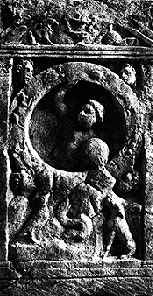
Mithras holding cosmic sphere and rotating zodiac
Another image shows Mithras in the role of the god Atlas, supporting on his shoulder the great sphere of the universe, as Atlas traditionally does.
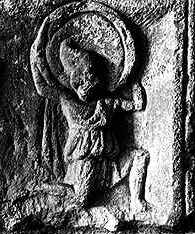
Mithras as Atlas
A further example is provided by a number of tauroctonies that symbolize Mithras's cosmic power by showing him with the starry sky contained beneath his flying cape (see illustration at beginning of article).
If Mithras was in fact believed to be capable of moving the entire universe, then he must have been understood as in some sense residing outside of the cosmos. This idea may help us to understand another very common Mithraic iconographical motif: namely, the so-called "rock-birth" of Mithras. This scene shows Mithras emerging from the top of a roughly spherical or egg-shaped rock, which is usually depicted with a snake entwined around it.
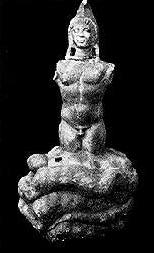
Rock-Birth of Mithras
As I mentioned previously, the tauroctony depicts the bull-slaying as taking place inside a cave, and the Mithraic temples were built in imitation of caves. But caves are precisely hollows within the rocky earth, which suggests that the rock from which Mithras is born is meant to represent the Mithraic cave as seen from the outside. Now as we saw earlier, the ancient author Porphyry records the tradition that the Mithraic cave was intended to be "an image of the cosmos." Of course, the hollow cave would have to be an image of the cosmos as seen from the inside, looking out at the enclosing, cave-like sphere of the stars. But if the cave symbolizes the cosmos as seen from the inside, it follows that the rock out of which Mithras is born must ultimately be a symbol for the cosmos as seen from the outside. This idea is not as abstract as might first appear, for artistic representations of the cosmos as seen from the outside were in fact very common in antiquity. A famous example is the "Atlas Farnese" statue, showing Atlas bearing on his shoulder the cosmic globe, on which are depicted the constellations as they would appear from an imaginary vantage point outside of the universe.
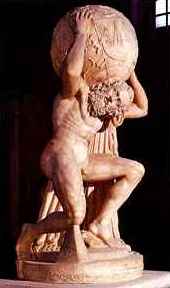
Atlas Farnese statue, 2nd century A.D.
That the rock from which Mithras is born does indeed represent the cosmos is proven by the snake that entwines it: for this image evokes unmistakeably the famous Orphic myth of the snake-entwined "cosmic egg" out of which the universe was formed when the creator-god Phanes emerged from it at the beginning of time. Indeed, the Mithraists themselves explicitly identified Mithras with Phanes, as we know from an inscription found in Rome and from the iconography of a Mithraic monument located in England.
The birth of Mithras from the rock, therefore, would appear to represent the idea that he is in some sense greater than the cosmos. Capable of moving the entire universe, he cannot be contained within the cosmic sphere, and is therefore depicted in the rock-birth as bursting out of the enclosing cave of the universe, and establishing his presence in the transcendent space beyond the cosmos.
This imaginary "place beyond the universe" had been described vividly by Plato several centuries before the origins of Mithraism. In his dialogue Phaedrus (247B-C) Plato envisions a journey by a soul to the outermost boundary of the cosmos, and then gives us a glimpse of what the soul would see if for a brief moment it were able to "look upon the regions without." "Of that place beyond the heavens," says Plato,none of our earthly poets has yet sung, and none shall sing worthily. But this is the manner of it, for assuredly we must be bold to speak what is true, above all when our discourse is upon truth. It is there that true being dwells, without colour or shape, that cannot be touched; reason alone, the soul's pilot, can behold it, and all true knowledge is knowledge thereof.
Beyond the heavensI would suggest that the awe-inspiring quality of Plato's vision of what is beyond the outermost boundary of the cosmos also lies behind the appeal of Mithras as a divine being whose proper domain is outside of the universe. As the text from Plato shows, the establishment by ancient astronomers of the sphere of the stars as the absolute boundary of the cosmos only encouraged the human imagination to project itself beyond that boundary in an exhilarating leap into an infinite mystery. There beyond the cosmos dwelled the ultimate divine forces, and Mithras's ability to move the entire universe made him one with those forces.
Here in the end we may sense a profound kinship between Mithraism and Christianity. For early Christianity also contained at its core an ideology of cosmic transcendence. Nowhere is this better expressed than in the opening of the earliest gospel, Mark. There, at the beginning of the foundation story of Christianity, we find Jesus, at the moment of his baptism, having a vision of "the heavens torn open." Just as Mithras is revealed as a being from beyond the universe capable of altering the cosmic spheres, so here we find Jesus linked with a rupture of the heavens, an opening into the numinous realms beyond the furthest cosmic boundaries. Perhaps, then, the figures of Jesus and Mithras are to some extent both manifestations of a single deep longing in the human spirit for a sense of contact with the ultimate mystery.
Excerpts from reviews of
The Origins of the Mithraic Mysteries:
Cosmology and Salvation in the Ancient World
by David Ulansey
(Oxford University Press, 1989; revised paperback, 1991)
"Fascinating."
--Scientific American, vol. 265, #3 (September, 1991) pp. 188-90.
"Thrilling.... Bravo for Ulansey."
--Religious Studies Review, vol. 17, #1 (January, 1991) p. 66.
"Brilliant and fascinating... entirely convincing....The reviewer
had trouble in putting it down."
--The Ancient World, vol. 23, #1 (1992) pp. 112-13.
"Ulansey has produced an astounding book."
--Critical Review of Books in Religion, vol. 4 (1991) pp. 277-79.
"Erudite, well-written, and fascinating to read.... Extremely successful."
--Bulletin of the Harvard University Center for the Study of World Religions,
vol. 16, #2 (1989-90) pp. 90-92.
"Remarkable.... In comprehensiveness [Ulansey's] theory appears
to have no rival."
--Ancient Philosophy, vol. 12 (1992) p. 242- 44.
"Brilliant and fascinating."
--Latomus, vol. 55, #2 (April-June 1996) pp. 496-98.
"Convincing.... All fits together beautifully."
--Journal of Religion, vol. 72, #2 (April, 1992) pp. 301-302.
"Brilliant.... an absolutely spell-binding detective story of antique
lore."
--Gnosis, #20 (Summer, 1991) p. 76.
"A remarkable and enthralling book."
--Zeitschrift für Geschichtswissenschaft, vol. 48, #7 (2000) pp. 652-53.
To go to Home of David Ulansey, click here.
To order The Origins of the Mithraic Mysteries (for $13.95), click here.
For those of you who have read my book, I have just completed several new appendices for a German translation that will appear shortly. To read these appendices in English, click here
For responses to a few critics of my book, click here.
For my article Mithras and the Hypercosmic Sun click here.
For my article The Eighth Gate: The Mithraic Lion-Headed Figure and the Platonic World-Soul click here.
For my article The Heavenly Veil Torn (from the Journal of Biblical Literature) click here.
For my article Cultural Transition and Spiritual Transformation: From Alexander the Great to Cyberspace click here.
If you'd like to send me your comments click here.
